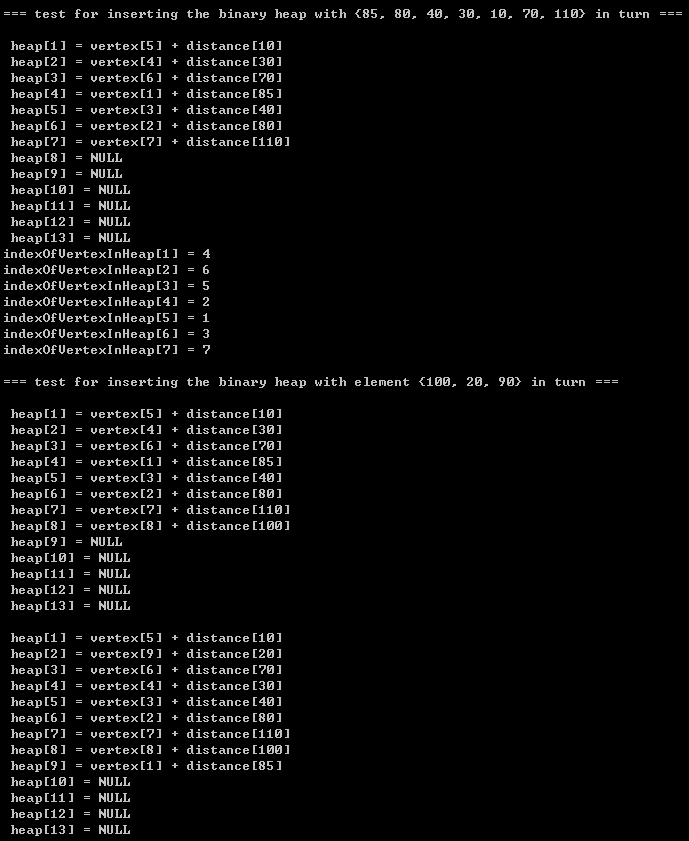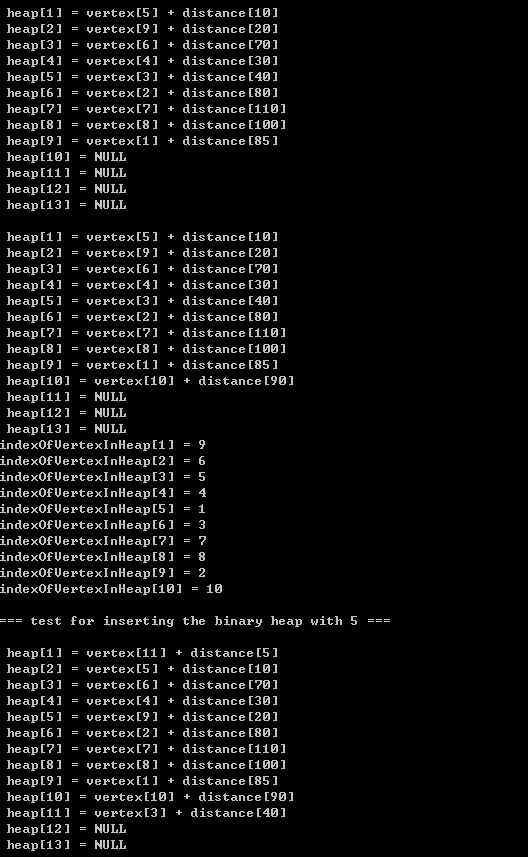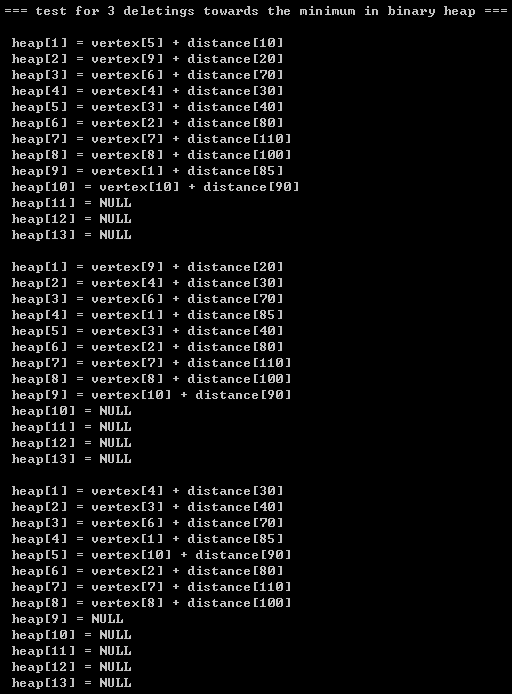【0】README
0.1)为什么有这篇文章?因为 Dijkstra算法的优先队列实现 涉及到了一种新的数据结构,即优先队列(二叉堆)的操作需要更改以适应这种新的数据结构,我们暂且吧它定义为Distance, 而不是单纯的int类型;
0.2)本文源代码均为原创, int类型的优先队列(二叉堆)的操作实现,参见http://blog.csdn.net/PacosonSWJTU/article/details/49498255, (并比较他们的打印结果,很有必要)
【1】因为 Dijkstra算法的优先队列实现, 需要用到二叉堆的相关操作,但是操作的元素类型(ElementType 不是 单纯的int类型), 而是如下:
struct Distance
{int vertexIndex; //当前顶点下标int distance; //初始顶点到当前顶点的distance
};【2】看个荔枝
2.1)需要特别说明的是: indexOfVertexInHeap 数组记录的是顶点vertex在 heap中的位置, 如 indexOfVertexInHeap [1] = 4;表明heap的第4个位置记录这 编号为1的vertex;
2.2)优先队列的insert和deleteMin 的执行演示(请将我的手动演示结果同我的代码打印结果做对比,经过对比,你发现它们的效果是一致的,恰好说明了我的代码的可行性):

Attention)
- A1)其实本文中的二叉堆优先队列的实现源代码和 int类型的优先队列源代码类似,只不过它们操作的数据类型不一样罢了,当然, 这只需要简单的修改即可;
- A2)打印结果在文末,可以看到,ElementType采用int 和 Distance的打印效果一样,这正证明了我们采用Distance结构体对源码的修改是无误的,相比于单纯的int 类型,只不过Distance又多了一个 顶点下标vertexIndex成员变量而已;
【3】source code + printing results
3.1)download source code:
https://github.com/pacosonTang/dataStructure-algorithmAnalysis/tree/master/chapter9/binaryHeap_dijkstra_prim
3.2)source code at a glance:(for complete code , please click the given link above)
1st file:distance.h
#include <stdio.h>#define Error(str) printf("\n error: %s \n",str) struct Distance;
typedef struct Distance *Distance;
struct Distance
{int vertexIndex;int distance;
};Distance makeEmptyDistance();2nd file:distance.c
#include "distance.h"
#include <malloc.h>// allocate the memory for Distance struct
Distance makeEmptyDistance()
{Distance element;element = (Distance)malloc(sizeof(struct Distance));if(!element){Error("out of space ,from func makeEmptyDistance");return NULL;} return element;
}
3rd file:binaryheap.h
#include <stdio.h>
#include <malloc.h>
#include "distance.h"#define ElementType Distance#define Error(str) printf("\n error: %s \n",str) struct BinaryHeap;
typedef struct BinaryHeap *BinaryHeap;void swap(ElementType x, ElementType y);
BinaryHeap initBinaryHeap(int capacity);
void insert(ElementType value, BinaryHeap bh, int*);
ElementType deleteMin(BinaryHeap, int*);
int isFull(BinaryHeap bh);
int isEmpty(BinaryHeap bh);
void percolateUp(int index, BinaryHeap bh);
void percolateDownFromOne(int index, BinaryHeap bh, int*);
void printBinaryHeap(BinaryHeap bh);
void printBinaryHeapFromZero(BinaryHeap bh);struct BinaryHeap
{int capacity;int size; ElementType *elements;
};4th file:binaryheap.c
#include "binaryheap.h"
#include <math.h>#define MaxInt (int)pow(2, 16)
//judge whether the BinaryHeap is full or not , also 1 or 0
int isFull(BinaryHeap bh)
{return bh->size == bh->capacity - 1;
}//judge whether the BinaryHeap is empty or not , also 1 or 0
int isEmpty(BinaryHeap bh)
{return bh->size == 0;
}// get the left child of node under index with startup 1
int leftChildFromOne(int index)
{return index * 2;
}void printBinaryHeap(BinaryHeap bh)
{int i;ElementType *temp;if(!bh)Error("printing execution failure, for binary heap is null, from func printBinaryHeap"); temp = bh->elements;for(i = 1; i < bh->capacity; i++){printf("\n\t heap[%d] = ", i);if(i <= bh->size)printf("vertex[%d] + distance[%d]", bh->elements[i]->vertexIndex+1, bh->elements[i]->distance); elseprintf("NULL");}printf("\n");
} //print the binary heap who starts from index 0
void printBinaryHeapFromZero(BinaryHeap bh)
{int i;ElementType *temp;if(!bh)Error("printing execution failure, for binary heap is null, from func printBinaryHeap"); temp = bh->elements;for(i = 0; i < bh->capacity; i++){printf("\n\t index[%d] = ", i);if(i < bh->size)printf("%d", bh->elements[i]->distance);elseprintf("NULL");}printf("\n");
} void swap(ElementType x, ElementType y)
{struct Distance temp;temp = *x;*x = *y;*y = temp;
}ElementType deleteMin(BinaryHeap bh, int* heapIndexRecord)
{ ElementType minimum;ElementType *data; if(isEmpty(bh)){Error("failed deleting minimum , for the BinaryHeap is empty, from func deleteMin !");return NULL; }data = bh->elements; minimum = data[1];swap(data[1], data[bh->size]); bh->size-- ; // size-- occurs prior to percolateDownFromOne percolateDownFromOne(1, bh, heapIndexRecord) ; return minimum;
} // percolating down the element when its value is greater than children (minimal heap)//Attention: all of bh->elements starts from index 1void percolateDownFromOne(int index, BinaryHeap bh, int* heapIndexRecord){ ElementType *data;int size;struct Distance temp;int child;data = bh->elements;size = bh->size; for(temp = *data[index]; leftChildFromOne(index) <= size; index = child){child = leftChildFromOne(index);if(child < size && data[child]->distance > data[child+1]->distance)child++;if(temp.distance > data[child]->distance){ *data[index] = *data[child]; heapIndexRecord[bh->elements[index]->vertexIndex] = index; //update the heapIndexRecord}elsebreak;} *data[index] = temp; heapIndexRecord[bh->elements[index]->vertexIndex] = index; //update the heapIndexRecord}// Attention, the index of the heap starts from 1
// return the index the element inserted into the binary heap
void insert(ElementType value, BinaryHeap bh, int* heapIndexRecord)
{int i;if(isFull(bh)){Error("failed insertion , for the BinaryHeap is full, from func insert!");return ; } if(!isEmpty(bh))for(i = ++bh->size; bh->elements[i/2]->distance > value->distance; i /= 2) {//copyElement(bh->elements[i/2], bh->elements[i]); *bh->elements[i] = *bh->elements[i/2];heapIndexRecord[bh->elements[i]->vertexIndex] = i; //update the heapIndexRecord}elsei = ++bh->size; *bh->elements[i] = *value;heapIndexRecord[bh->elements[i]->vertexIndex] = i; //update the heapIndexRecord
}BinaryHeap initBinaryHeap(int capacity)
{BinaryHeap bh;ElementType *temp;int i;bh = (BinaryHeap)malloc(sizeof(struct BinaryHeap));if(!bh) {Error("out of space, from func initBinaryHeap"); return NULL;} bh->capacity = capacity;bh->size = 0;temp = (ElementType*)malloc(capacity * sizeof(Distance));if(!temp) {Error("out of space, from func initBinaryHeap"); return NULL;} bh->elements = temp;for(i=0; i < capacity; i++){temp[i] = (ElementType)malloc(sizeof(struct Distance));if(!temp[i]) {Error("out of space, from func initBinaryHeap"); return NULL;} }return bh;
}// allocate the memory for storing index of vertex in heap and let every element -1
int *makeEmptyArray(int size)
{int *array;int i;array = (int*)malloc(size * sizeof(int));if(!array){Error("out of space ,from func makeEmptyArray");return NULL;} for(i=0; i<size; i++)array[i] = -1;return array;
} void printIndexOfVertexInHeap(int size, int *array)
{int i;for(i=0; i<size; i++) printf("\tindexOfVertexInHeap[%d] = %d\n", i+1, array[i]);
}int main()
{int data[] = {85, 80, 40, 30, 10, 70, 110}; // P141 int buildHeapData[] = {150, 80, 40, 30, 10, 70, 110, 100, 20, 90, 60, 50, 120, 140, 130};BinaryHeap bh; int size;int i; int capacity;Distance tempDisStruct;int *indexOfVertexInHeap;printf("\n\t=== test for inserting the binary heap with {85, 80, 40, 30, 10, 70, 110} in turn ===\n");capacity = 14;bh = initBinaryHeap(capacity);size = 7; tempDisStruct = makeEmptyDistance(); indexOfVertexInHeap = makeEmptyArray(size);for(i = 0; i < size; i++) {tempDisStruct->distance = data[i];tempDisStruct->vertexIndex = i;insert(tempDisStruct, bh, indexOfVertexInHeap);} printBinaryHeap(bh);printIndexOfVertexInHeap(bh->size, indexOfVertexInHeap);printf("\n\t=== test for inserting the binary heap with element {100, 20, 90} in turn ===\n");tempDisStruct->distance = 100;tempDisStruct->vertexIndex = size;insert(tempDisStruct, bh, indexOfVertexInHeap); printBinaryHeap(bh);tempDisStruct->distance = 20;tempDisStruct->vertexIndex = size+1;insert(tempDisStruct, bh, indexOfVertexInHeap); printBinaryHeap(bh);tempDisStruct->distance = 90;tempDisStruct->vertexIndex = size+2;insert(tempDisStruct, bh, indexOfVertexInHeap); printBinaryHeap(bh);printIndexOfVertexInHeap(bh->size, indexOfVertexInHeap);printf("\n\t=== test for inserting the binary heap with 5 ===\n"); tempDisStruct->distance = 5;tempDisStruct->vertexIndex = size+3;insert(tempDisStruct, bh, indexOfVertexInHeap); printBinaryHeap(bh);printf("\n\t=== test for 3 deletings towards the minimum in binary heap ===\n");deleteMin(bh, indexOfVertexInHeap); printBinaryHeap(bh);deleteMin(bh, indexOfVertexInHeap); printBinaryHeap(bh);deleteMin(bh, indexOfVertexInHeap); printBinaryHeap(bh);
}3.3)printing results:





)
)

)





算法)



算法)




